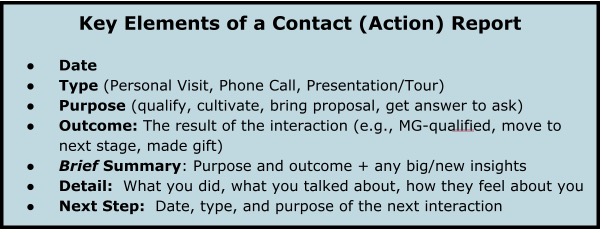FIVE-POINT PLAN TO SET UP A PROSPECT TRACKING SYSTEM
If you write it down, it’ll happen.
Look at your portfolio. Do you have a cultivation plan for each of your qualified* prospects? By plan, we mean how much, for what, when, and HOW you’ll get to the ask. Nonprofits use Prospect Tracking to reach fundraising goals by making sure there’s a plan for every ask. And that everything goes as planned.
*A qualified prospect has been “qualified” by a fundraiser as having the capacity and likelihood of making a gift as a result of direct engagement.
WHAT IS PROSPECT TRACKING?
Prospect tracking is a method of systematically managing and monitoring major gift fundraising efforts through data.
HOW DOES PROSPECT TRACKING HELP YOU RAISE MONEY?
Prospect tracking helps you think clearly and act intentionally throughout the prospect engagement process to inspire your donors to give generously. Nonprofit leaders use prospect tracking systems to monitor and manage the progress of donor engagement strategies for their entire prospect pipeline. They do it to be sure you reach your fundraising goals.
Want to take a direct path to your biggest gifts? Use a prospect tracking system.
5-POINT PLAN TO SET UP A PROSPECT TRACKING SYSTEM
Before you start: Prospect Tracking begins and ends with data you record in your CRM.
1. Record the plan and the players.
Set up a ‘prospect’ file for each individual in your portfolio–This is the place where you record the vital statistics of your plan*:
- Capacity Rating
- Cultivation Stage
- Ask Amount
- Ask Date
- Ask Purpose
- Ask Readiness
- Prospect Manager (Lead fundraiser)
- Team (who will help in engaging and asking)
*As you grow a deeper connection with the prospect–and closer to the ask–you need to keep this data updated.

2. Set specific timeframes for each stage of cultivation.
Here are commonly used timeframes for each cultivation stage:
- Qualification/Discovery (60-90 days)
- Cultivation (6-12 months)
- Solicitation (2-3 months)
- Stewardship (6-12 months–longer if the prospect is paying off a pledge)

3. Document significant moves.
Use the Contact Reports area of the prospect/donor’s CRM record to document your significant interactions with them. RULE of THUMB: An interaction is “significant” if it moves the prospect closer to making a gift.


4. Report.
With tracking data you record in the prospect and contact report records, you can build reports that will benefit both individual fundraisers and your nonprofit’s leadership. Consider creating these (SORTABLE) reports to start:
- Fundraiser Portfolios (list prospects by name, stage, rating, ask amount, ask date)
- Pipeline Reports (list prospects by ask date and amount–use to project fundraising revenues)
- If you’re feeling ambitious, you can build data dashboards that show progress vs. plan (goals)

5. Make it a policy and a process for everyone to follow.
Nonprofits use prospect tracking to measure performance and plan for the future so it’s vital that the whole fundraising team participates.
With a strong prospect tracking system, you have a systematic way of working your plans and achieving your fundraising goals.

DID YOU KNOW?
You can efficiently build stronger prospect portfolios by including your prospect tracking data in DonorSearch custom profiles and portfolios. Learn more about these powerful prospect management tools:
Click GET A DEMO below.
